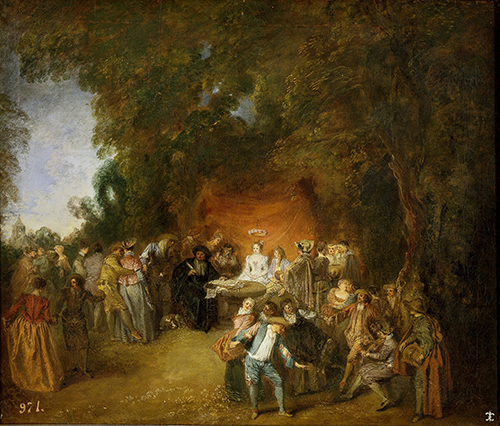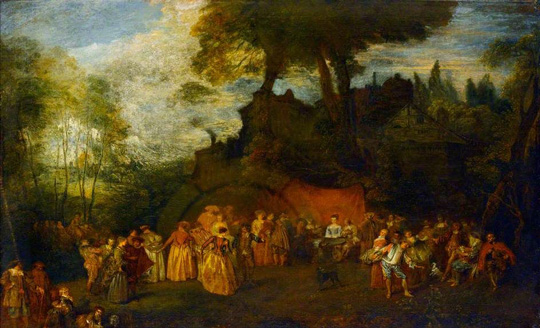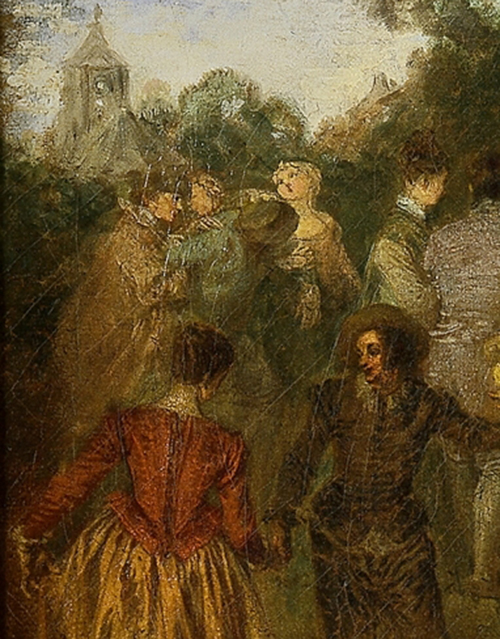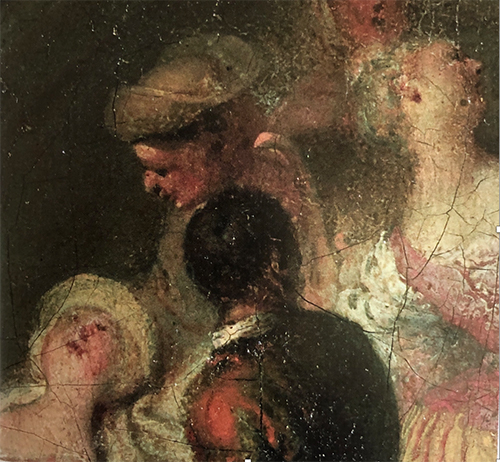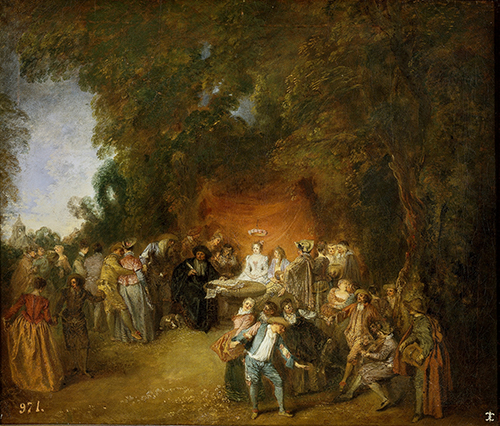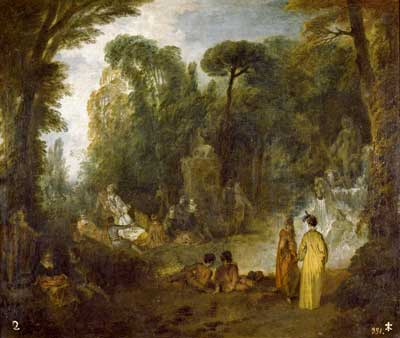
- Home Page
- Accepted
Paintings & Copies - Doubtful
Attributions - Doubtful Textual References
- Alternative
Titles - Collectors &
Museums - Bibliography
- Search Abecedario
- Watteau &
His Circle
Le Contrat de mariage
Entered July 2019; revised June 2020
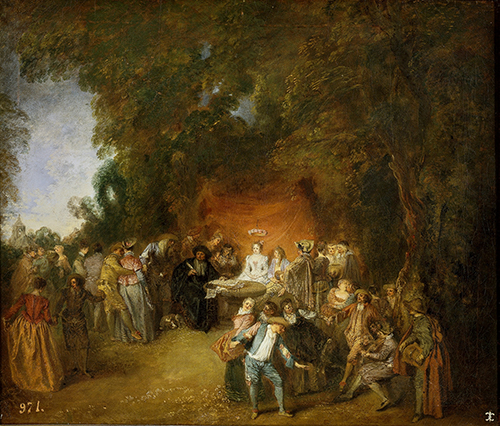
Madrid, Museo Nacional del Prado, inv P002353
Oil on canvas
47 x 55 cm
ALTERNATIVE TITLES
L’Accordée de village
Betrothal and Rustic Dance
Capitulaciones de boda
Capitulaciones de boda y baile campestre
Une Fête champêtre
Fiançailles et bal champêtre
Heiratskontrakt
Heiratsvertrage
La Mariée de village
Marriage Contract
Marriage Contract and Country Dance
Les Noces
Les Préparations d’une noce
Wedding in the Country
RELATED PRINTS
Neither Le Contrat de mariage nor its pendant, Fête galante près d’une statue de Neptune, were engraved for Jean de Jullienne’s Oeuvre gravé.
PROVENANCE
Segovia, Palacio de La Granja de San Ildefonso, collection of Isabel Farnese. 1746 inventory, no. 51.
Segovia, La Granja, 1766 inventory, no. 51.
Madrid, Palacio de Aranjuez, 1794 inventory, no. 51.
Madrid, Palacio Real, Madrid, 1814-18 inventory, no. 51.
EXHIBITIONS
Paris, Petit Palais, Le paysage français (1925), cat. P.350 (Watteau, Fiançailles et bal champêtre, lent by the Museo del Prado).
Bordeaux, Galerie des beaux-arts, L’Art européen (1979), cat. 94 (Watteau, Le Contrat de mariage, lent by the Museo del Prado).
Madrid, Prado, El arte Europeo en la corte de Espana (1980), cat. 99 (Watteau, Capitulaciones de boda y baile campestre, lent by the Museo del Prado).
Washington, Paris, Berlin, Watteau 1684-1721 (1984), cat. 21 (Watteau, The Marriage Contract [Le Contrat de mariage], lent by the Museo del Prado).
Madrid, Prado, El arte en la corte de Felipe V (2002).
Valenciennes, Musée, Watteau et la fête galante (2004), cat. 28 (Watteau, Le Contrat de mariage, lent by Museo nátional del Prado).
Brussels, Watteau et les chemins de la sensualité (2013).
Brussels, Palais des beaux-arts, Watteau, Leçon de musique (2013), cat. 23 (Watteau, Le Contrat de mariage, lent by the Museo national del Prado); under cat. 99.
Madrid, Prado, Captive Beauty: Fra Angelico to Fortuny (2013), cat. 61 (Watteau, Fête galante, lent by the Museo del Prado).
Madrid, Prado, Goya en Madrid (2014), cat. 3.30 (Watteau, Capitulaciones de boda y baile campestre).
SELECT BIBLIOGRAPHY
Eusebi, Noticias de los Cuadros (1828), 143, cat. 533.
Ponz, Viaje de España (1772-94), 10: 140.
Clément de Ris, Le Musée royal de Madrid (1859), 147.
Blanc, Histoire des peintres. École française (1862-63), 3: 8.
Lejeune, Guide théorique et pratique (1864), 1: 213.
Goncourt, Catalogue raisonné (1875), cat. 971.
Dussieux, Artistes français à l’étranger (1876), 382.
Mantz, Watteau (1892), 188.
Mabilleau, “La Peinture française” (1895), 418-19.
Staley, Watteau (1902), 144.
Calvert, The Prado (1907), xvi.
Ricketts, Art of the Prado (1907), 39-40.
Pilon, Watteau et son école (1912), 77.
Zimmermann, Watteau (1912), pl. 33.
Madrazo, Catálogo de los cuadros (1920), 404.
Nicolle, “Watteau dans les musées d’Espagne” (1921), 147-50.
Dacier, Vuaflart, and Hérold, Jean de Jullienne et les graveurs (1921-29), 1: 172.
Nicolle, La Peinture française (1925), 44.
Réau, “Watteau” (1928), cat. 87.
D’Ors, Trois heures (1928), 40.
Guiffrey, “Le Peintre-graveur Quillard" (1929), 70-73.
Hevesy, “Amico di Watteau” (1929), 542.
Miller, “Autour de Watteau” (1930), 135-36, 141-42.
Alvin-Beaumont, Le Pedigree (1932), 60-63, 70-95.
“Quillard” in Thieme and Becker, Allgemeines Lexikon (1907-1950), 27: 522-23.
Sánchez-Cotán, Madrid, Prado, Catálogo (1933), 505.
Mathey, “A Propos d’un catalogue” (1938), 162-65.
Sánchez Cotán, Museo del Prado (1949), 28.
Adhémar, Watteau (1950), cat. 134.
Pantorba, Guide du Musée du Prado (1950), 232.
Sánchez Cotán, Prado Museum (1951), 26.
Sánchez Cotán, Museo del Prado (1952), 740.
Gaya Nuño, Historia y guía (1955), 400.
Parker and Mathey, Watteau, son oeuvre dessiné (1957), cat. nos. 25, 49, 74, 135, 193.
Mathey, Watteau, peintures réapparues (1959), 67, 77.
Sánchez Cotán, Trésors (1959), 29.
Bottineau, L’Art de cour (1960), 461.
Madrid, Prado, Catálogo (1963), 776.
Lemagny, “Quillard” (1967), 209, 211.
Macchia and Montagni, L’opera completa di Watteau (1968), cat. 94.
Eidelberg, “Quillard, Assistant to Watteau” (1970), 41, 49-53, 59, 66-67.
Ferré, Watteau (1972), 3: 964-65, cat. B28.
Lorente & Panchaud, Le Prado-Madrid (1973), 2: cat. 237.
Rosenberg, Pitture francese (1977), 186.
Madrid, Prado Museum, El Arte Europeo (1980), cat. 99.
Luca de Tena and Mena, Guide du Prado (1980), 281.
Roland Michel, Watteau (1984), 215, 223, 270.
Posner, Watteau (1984), 278 n. 23, 284 n. 8.
Bottineau, El arte cortesano (1986), 468-69, 478-79.
Garrido, "Capitulaciones de boda y baile campestre" (1989), 55-65.
Luna and Úbeda, Pintura Europea (1997), 46.
Madrid, Prado, Catálogo (1996), 446.
Rosenberg and Prat, Watteau, Catalogue raisonné des dessins (1996), cat. 75, 77, 117, 120, 130, 146, 164, 169, 510, 650.
Aznar Almazán, "Melancolía: las 'fiestas galantes'" (1999), 87-107.
Temperini, Watteau (2002), 44, cat. 34.
Aterido, Cuesta, and Pérez Preciado, Colecciones de pinturas (2004), 2: 43, 287, 487-88.
Wyngaard, From Savage to Citizen (2004), 64-66.
Glorieux, “Tableaux remarquables passés en vente” (2006), 74.
Alcolea i Blanch, Prado Museum (2008), 365, 376.
Glorieux, Watteau (2011), 156, 158.
Brussels, Palais des beaux-arts, Watteau, Leçon de musique (2013), 81, 168, 200, cat. 23.
Glorieux, "Quillard" (2019), https://www-degruyter-com.ezproxy.inha.fr:2443/view/AKL/_00171507T
“Marriage Contract and Country Dance,” (2019), https://www.museodelprado.es/en/the-collection/art-work/marriage-contract-and-country-dance/011a63d7-d68a-4806-86a9-c9431e13a5fa
RELATED DRAWINGS
Defining which drawings Watteau used for Le Contrat de mariage is complicated by the fact that some of the figures in this work also appear in L’Accordée de village, and there is no certainty as to which version was painted first, although we favor L’Accordée. In regard to those figures who appear in both paintings, the question is whether Watteau copied the painted ones or returned to his original drawings.
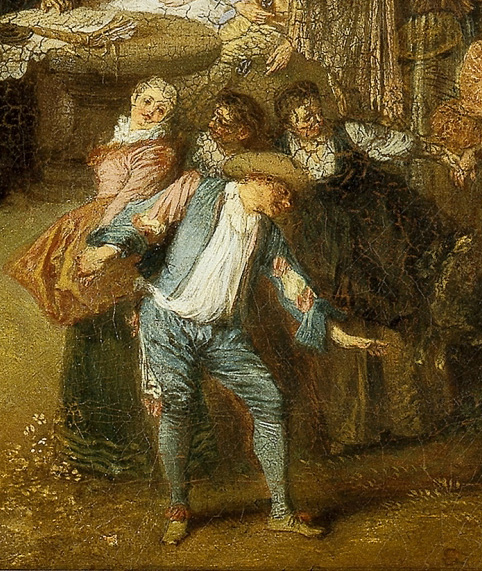
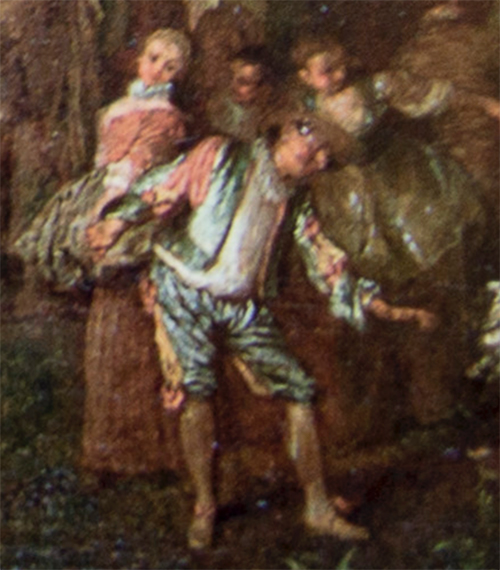
Watteau, L’Accordée de village (detail).
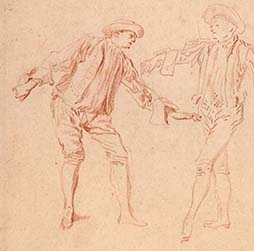
For example, the two principal dancers in both paintings are related to Watteau studies. The drawing for the woman arching her body, her head turned back over her shoulder, has not survived but is recorded in plate 11 of the Figures de différents caractères. The study of the dancing man is now in the British Museum, one figure on a larger sheet (Rosenberg and Prat 130). In these two instances, I think that one would be hard put to decide how Watteau had operated.
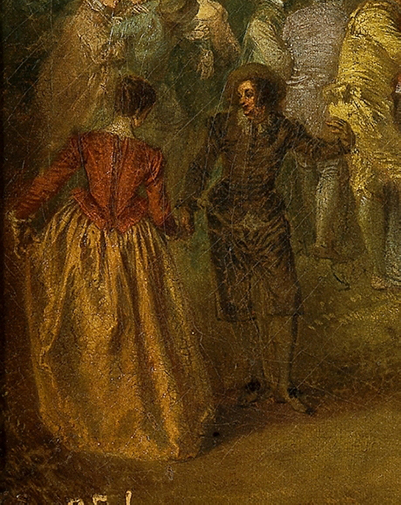
Watteau and Quillard, Le Contrat de mariage (detail).
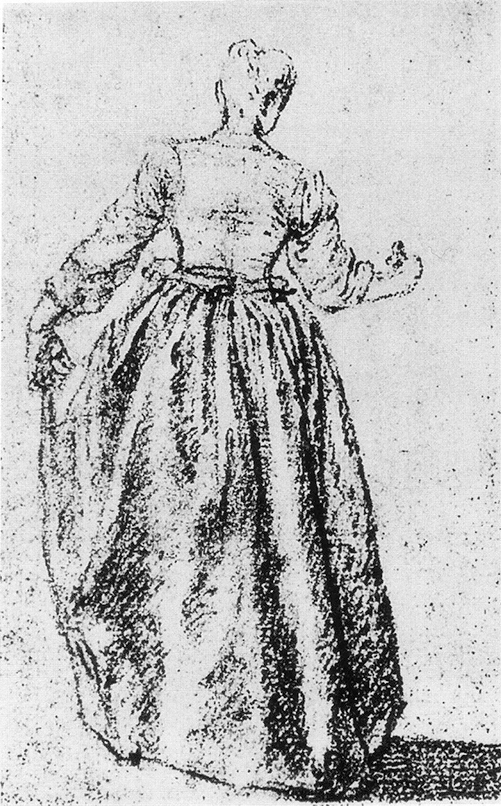
Watteau, Study of a Woman Dancing, red chalk, 13 x 8 cm. Whereabouts unknown.
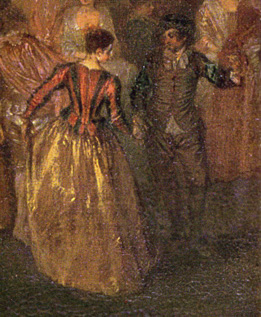
Watteau, L’Accordée de village (detail).
The woman and man dancing in the left foreground of Le Contrat de mariage also appear near the center of L’Accordée de village. Whether Watteau turned to his study of the woman (Rosenberg and Prat 120) or L’Accordée is not certain, but it would seem that he relied on the drawing. In the drawing and Le Contrat de mariage her face is not at all visible and the jacket of her costume is plain, whereas in L’Accordée de village, her head is turned into a profil perdu and her jacket is elaborately striped. The drawing for the man has not survived. Watteau used it for Le Contrat de mariage but not for the Soane Museum painting. On the other hand, he did employ it again for a dancer at the center of Le Plaisir pastoral, another relatively early painting.
Le Contrat de mariage shares a number of other figures with L’Accordée de village and there are drawings that can be associated with both versions, but no determination can be made whether he took these figures from the London painting or returned to his original study from the model. These instances include the old man with a cane (Rosenberg and Prat 75), the seated notary (Rosenberg and Prat 77), the man standing close to the marital group (Rosenberg and Prat 117), and the groom (Rosenberg and Prat 650).
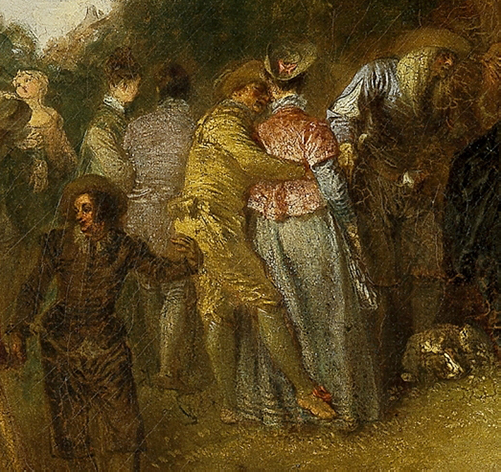
Watteau and Quillard, Le Contrat de mariage (detail).
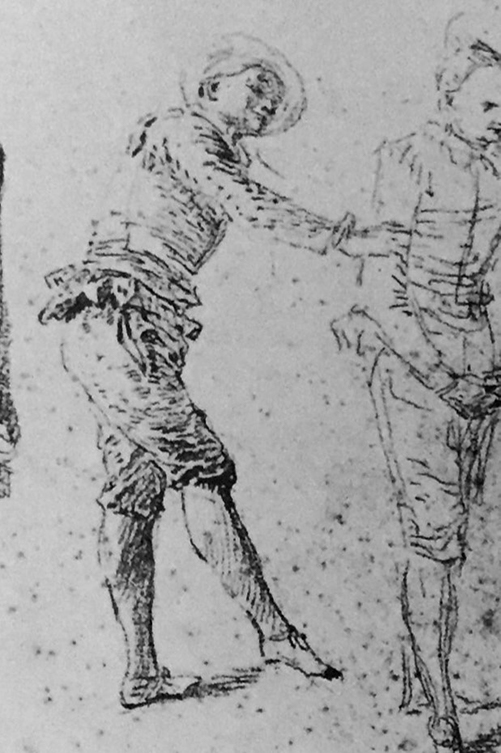
Watteau, Sheet with Four Studies of Actors (detail), red chalk. Whereabouts unknown.
The male dancer embracing his partner from behind in the Prado painting is taken from a sheet of four studies discovered by Jean Cailleux (Rosenberg and Prat 146). This figure was not used for the Soane Museum’s painting, and is one of the few instances where it can be shown that the Prado painting has inventions that could not have come from a pasticheur—which is what Posner implied.
REMARKS
As has been noted, Le Contrat de mariage has strong ties to Watteau’s oeuvre, especially to his L’Accordée de village in Sir John Soane’s Museum. Indeed, one is a variation of the other, and though there is some disagreement, it is generally conceded that L’Accordée de village is the earlier.
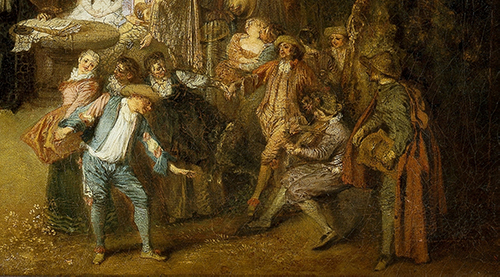
Watteau and Quillard, Le Contrat de mariage (detail).
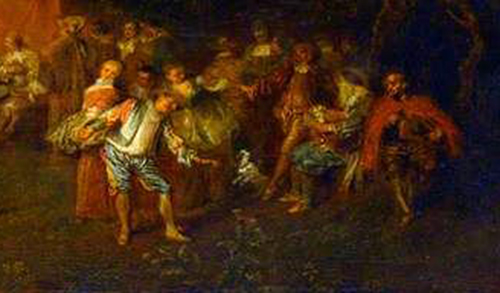
Watteau, L’Accordée de village (detail).
The figures in the London painting are stiffer and less rhythmic in pose. Likewise, the composition of the London painting has more figures, and is stretched out, whereas the Prado painting is more cohesive and cogent . A comparison of the musicians and ring of dancers in the foregrounds of both paintings demonstrates the greater mastery in the London version. Whereas the hurdy-gurdy player in the London painting sits to the side, essentially a frontally posed figure who barely turns his head toward the dancers, in the Prado painting he stands and faces across to the dancers. The same is true for the violinist, who sits stiffly in the Soane painting but in the Prado version he leans forward, even while still seated, and is more rhythmic and expressive of the music he is playing.
The date assignable to the Prado painting is elusive, as always with Watteau’s oeuvre. Roland Michel proposed c. 1710-12; Mathey thought c. 1712-13; Eidelberg suggested c. 1712-14,; Adhémar extended the possible date to 1716; finally some, such as Temperini and Glorieux, have used an all-inclusive date of 1712-16.
Throughout the eighteenth and nineteenth centuries, Le Contrat de mariage was accepted as a painting by Watteau. It had a good provenance, having been in the Spanish royal collection since the early years of the eighteenth century. Although it was not engraved in Jean de Jullienne’s Oeuvre gravé, it was closely related to the very similar L’Accordée de village, which had been engraved under Watteau's name for Jullienne’s corpus. Thus, for these reasons and the painting’s evident high quality, the attribution seemed secure. That reasoning stayed firmly in place until the late 1920s when the Quillard scandal broke out. The Louvre had bought two fête galantes thinking they were by Watteau but then they were reattributed to Pierre Antoine Quillard, and a war of reattribution broke out among French and Portuguese scholars. At that point, Quillard was recognized as a relatively obscure follower of Watteau who settled in Portugal in the mid-1720s, and for the next decade not only painted fêtes galantes for King Jao V and his court, but also executed large religious paintings and portraits and engraved historical subjects. In the haste to establish Quillard’s oeuvre, issues became muddled.
Caught up in the polemic was the pair of pendants in the Prado—Le Contrat de mariage and L’Assemblée près d’une fontaine de Neptune. Although the critical literature until then had full-heartedly accepted the works, now they suddenly were rejected. Guiffrey claimed they were irrefutably by Quillard, and this was agreed to by Jules Strauss as well as Dacier and Vuaflart. Nicolle thought that the attribution to Watteau was doubtful. But there were some, like Valentin Miller, who vigorously sought to retain the old attribution to Watteau. After World War II, when there was little interest in Quillard, most scholars returned to the old attribution to Watteau. They recognized that there had been a quarrel, but acquiesced and accepted the traditional attribution of the Prado paintings to Watteau. Although Macchia and Montagni listed them among Watteau’s works, they found it difficult to accept them as being by Watteau. Even more extreme was Donald Posner, who opposed any association of the Prado paintings with the artist.
In the 1920s when critics favored an attribution to Quillard, they focused on certain areas of the two pendants. In Le Contrat de mariage, Guiffrey pointed out “Les caractères des visages aux traits si aigus, le style poupin de certains figures, la disposition de plusieurs groupes sont bien significatifs.” Nowhere are the traits of Quillard more visible than in the figures in the background at the left side of the Prado’s Le Contrat de mariage. In 2004, when the painting was on view in Valenciennes, Marianne Roland Michel and I stopped before it and cast a strong light on this section and she exclaimed with great surprise, “Why, that is Quillard!” Indeed, while one senses Watteau’s presence everywhere else in the painting, Quillard’s mannerisms are clearly evident in this one area, especially the woman who raises her head and exposes the underside of her chin. She is not only atypical of Watteau, she shows the unmistakable mark of Quillard’s hand. Similar women with contorted heads and elongated undersides of chins appears in so many of his paintings and etchings that this could be considered his signature. The remainder of the Prado painting is consonant with Watteau’s manner, but this small pocket of lesser figures in the background is not. Thus, first in 1950 and subsequently elsewhere, I proposed that both Prado paintings are workshop collaborations—an interpretation that has not been accepted by many. Undoubtedly some of the resistance is due to the romanticized notion that Watteau was an isolated genius. But it is increasingly clear that the doors of his workshop were open to assistants and other artists, including not only Pater but also Lancret, Quillard, and Mercier.
Rosenberg added additional challenges to those already surrounding the two Prado paintings. Most notably, he questioned whether the two paintings were actually pendants. He objected that the two works have seemingly unrelated subjects—a wedding scene and a fête galante in a garden. Yet these two subjects fit well together, and the emphasis on music making and dancing in Le Contrat (noticeably absent in Assemblée près d’une fontaine de Neptune) help bridge the two scenes of public entertainment. Rosenberg also objected to the slight difference in measurements between the two canvases, proposing that strips of canvas added to the bottom and possibly at the side of Le Contrat de mariage are evidence of retrofitting to make them matching pendants. Rosenberg also was troubled by what he saw as a difference in the scale and number of figures. While the Assemblée près d’une fontaine de Neptune has many, smaller scale figures throughout the landscape, Watteau’s placement of the two figures in the right foreground helps to compensate. If the two paintings are not a perfect match, neither are some of Watteau’s other sets of pairs, such as the L’Amour au théâtre français and L’Amour au théâtre italien. Not least, the fact that both canvases contain background figures painted by Quillard prove that they were painted at the same time. The two Prado pictures have so much in common that they must have been intended as pendants, if not initially, then by the time they left Watteau’s studio.
Click here for copies of Le Contrat de mariage
